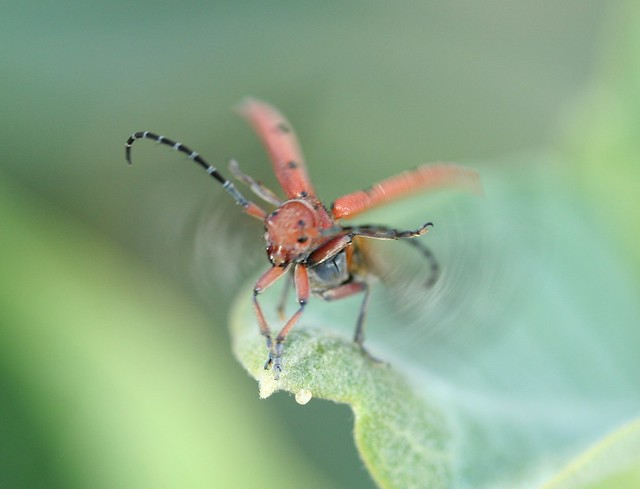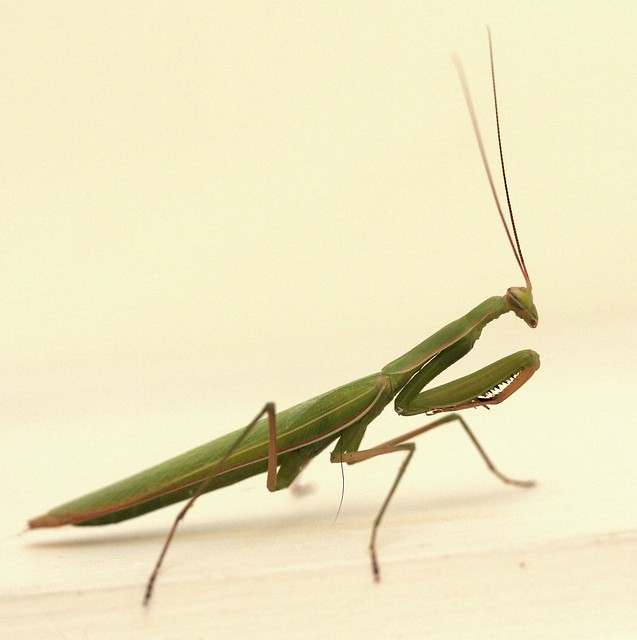Thursday, December 29, 2011
An anti-horse-slaughter screed
Hey, c'mere. I want to show you something.
See this piece of paper, here? It's an export health certificate. There are a million different types of these. This particular one is for exporting multiple horses from the US to Canada for slaughter.
There's a horse-trader in town. What you'd call the kill buyer. They ship 30 horses to Canada, every week without fail. Each shipment must be inspected by a veternarian, and the health certificate must be typed up by that vet's office. Guess who gets to type them up.
There's not a lot that goes into it. There is an ID number and brief description of each horse (provided by the shipper). All we do is have a vet inspect the horses and then put his signiture on a list of requirements that each animal must pass before they are able to cross the border. Here are the requirements and my comments:
1) Be 6 months of age or older. (Most kill buyers only want larger, therefore fully adult, horses so this usually isn't an issue - I believe this statement is on there so that mares aren't sent with nursing foals. But in theory, a robust 4 month old could easily be mistaken for a 6 month old. It's not like anyone's checking papers, here.)
2) Be able to stand and walk.
3) Not be pregnant enough to give birth during transport or on the slaughterhouse floor (This is difficult, even for a vet, to judge from simply glancing at a mare. How many people have bought a mare and had a "surprise" foal show up a week later because no one noticed she was pregnant? It's not like the vet is doing an ultrasound, here.)
4) Show no evidence of "communicable disease" (which translates to: "no obvious runny nose or cough"; the vet is not required to take temperatures, or test fecal samples, or anything else besides look for snot.)
5) Not be blind in both eyes. (This could easily be missed unless there is extreme cloudyiness in both eyes or both eyes are atrophied or missing)
6) Have resided in the US or Canada since birth. (I have no idea how the trader or the vet would know this, since the vast majority of these horses are purchased at auction days or weeks before being shipped with potentially zero known history)
7) The horses must not have set hoof in Texas or New Mexico in the last 21 days. Again, see my point at number 5.
8) Must not have any condition that could be made worse by shipping that would cause the animal to suffer. This is quite vague, and open to a lot of interpretation.
Basically, except for the "being able to walk" part, these are all either unenforceable with the current record-keeping requirements (basically none), inspection requirements (small), or very vague. I suspect, what the USDA's being all, "sheesh, calm down about those isolated incidents, guyz, here we'll put in some language that will magically make transportation of slaughter-bound horses humane."
Now, before I go any further, let me just get a couple things out of the way. Being a veterinary technician at a large animal vet in a rural, mostly conservative, town means I've had the privelege of standing quietly in the background while horse owners chat or rant with each other or the doctors about all kinds of subjects, including horses slaughter. Each and every person with a pro-slaughter slant seems to think those of us who are against it are stupid, sentimental blubber-heads who don't know what it's like in "the real (horse) world".
"Stupid" is too subjective to quantify. But I am not, by any measure, sentimental. I have nothing against killing horses per se. I have nothing against the consumption of horse meat per se. Under the right circumstances, I'd be happy to eat horse meat myself. I'm a big-game hunter. I have no problem shooting large animals, cleaning the carcuss, butchering and eating the meat.
So anyone who'd like to dismiss my opinions on that basis, let us just move on to the facts.
(I fully admit that many who are anti-slaughter are very sentimental. That doesn't mean they're wrong.)
Horse slaughter advocates are only in it for the money. They try to distract from their main motivation by talking about "high quality meat" that could "feed the hungry", but it's all really about making a few bucks. They even admit it, to a certain degree: The United Organizations of the Horse, a political organization primarily focused on lobbying to make horse slaughter easier, says they support "the right of others to market their horses in a way that provides financial return, and a valuable commodity, high quality meat, that is welcomed by a worldwide market. " (emphasis mine)
Financial return is really the only benefit for the current model of horse slaughter. A horse owner can make a few bucks from their horse instead of having to spend money to train; or market; or feed for a few more years; or humanely euthanize and ship to a zoo or large cat sanctuary; or send to a rendering plant; or rent a bulldozer to dig a hole in the back pasture, etc.
Of course, there are many "unwanted" (or just unmarketed or unlucky) horses that can't be sold for slaughter, either legally, or because even the kill buyer doesn't want them. If the horse is too old, too lame, sick, injured, too pregnant, too skinny, etc, then the owner still has to find an alternative to slaughter. Kill buyers are looking for fat, healthy horses because they bring more money per shipment. Any argument about how slaughter helps people dispose of "Old Lame Nessy" is pure BS.
The "environmental cost" of not being able to slaughter horses is BS, too. Something between 90%-99% of the total population of horses that die every year in the US do so without going through a slaughter plant. Why not the other 10%? Not to mention that pro-slaughter people regularly forget that rendering plants are still alive and well and plentiful and LEGAL in in the US. They probably forget about them because, you just don't make much money, if any, from sending your horses remains there.
Horse slaughter is not humane in its current form. Now, the CAFO's (beef, pork, and poultry industries) have their own humane issues to deal with, but that's an issue for another day. Because horse slaughter is very different from other types of meat production, and you can, in fact, deal with them separately. (For the record, I'm not a fan of farmed elk, either).
Horse slaughter is most closely modeled after cattle, but they're two very different creatures. Horses are naturally more flighty, nervous, and prone to panic than any of the popular meat animals. They have a long, upright neck and longer legs. No one would dream of putting a horse in a head-catch, yet somehow it's ok to put them through slaughter plants designed for cattle? In theory, it's probably possible to build a slaughter facility that is humane for mass slaughter of horses, but I doubt anyone will bother building it.
Speaking of cattle, let me show you something else from work:
The first is a label from a cattle drug. It has been extensively tested and you know exactly how long to wait before the animal can safely be slaughtered for human consumption. The second is a relatively common drug used in horses. It's just one of many equine products not meant for meat animals.
I think I've seen one or two drugs that have actual withdrawl times for horses, and if I remember what they are I'll photograph them, but the majority don't. Think of phenylbutazone, which every horse owner knows affectionately as "bute". Most horse owners keep a few tubs of powder or tubes of paste on hand and give it out like candy. Who even keeps track of who got some 'bute, anyway? It doesn't matter, since no one is keeping track of drug or other contamination in horse meat. In the cattle, pork, poultry industry, it's much more tightly controlled. There are records on every animal. The meat, milk, and eggs are tested periodically by the USDA.
Much of it comes down to this: Some animals are bred and raised to be eaten. Horses are not (at least not in the US or Canada).
And as far as us anti-slaughter advocates not "living in the real world": that's rich coming from people who are basically freaking out that they can't make a living breeding horses in the 21st century. To them I say: cry me a river. Things change, time marches on, technology moves on. Horses are a luxury item now. Start treating them as such instead of cheap, throw-away items to be slaughtered by the thousands. Maybe you'd get better prices for them.
Also check out the recent discussion on this topic at Fugly Horse of the Day:
http://fuglyblog.com/2011/12/27/halter-horses-yummy/
http://fuglyblog.com/2011/12/22/the-slaughter-debate/
http://fuglyblog.com/2011/12/23/the-slaughter-debate-rages-on/
Monday, December 19, 2011
Solstice
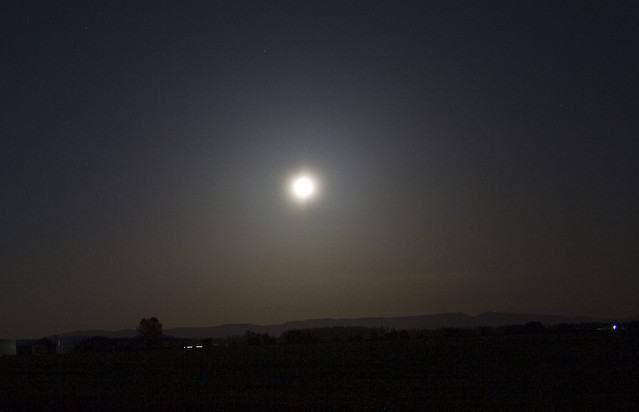
I've noticed something interesting since I started fostering Holly; black dogs are easy to see in the dark, but tan dogs are invisible after dusk. It seems counter intuitive (a lighter color should reflect more light, right?), until you go on a night walk (a necessity right now since it's dark long before I get out of work). If you're anywhere near a town, there is more than enough light pollution to see just fine after a few minutes without a flashlight. Once your eyes have adjusted, you can see that the night isn't that dark. The coal-black of a border collie's coat stands out against everything except the deepest shadow. Holly is impossible to spot until she's about 20 feet away. Sometimes you can see her white chest and tail tip moving, eerily independent of any other obvious form.
The place I go walking now adays is on some vacant land near a dry canal. Mostly we walk on the old, weed-infested service road that follows along the banks of the canal. I haven't lived here long enough to know if it will run with water come summer. Every year there are more and more abandoned canals; they're being replaced with underground pipes. Less leakage. Suits me fine. I like to walk down in the middle of the canal sometimes. It's darker and harder to see. The risk from a twisted angle is greater as there are a lot of loose rocks. But it provide amazing protection from the wind, which this time of year feels like someone pressing handfuls of ice cubes against the sides of my face even when I'm wearing a hat.
I use to do a lot of night hikes as a teenager. Sometimes with a friend, but usually by myself and the dog. I grew up was in the middle of the Oregon coastal rain forest and had miles of logging road at my disposal. I'd bring a flashlight but rarely turn it on. Even out there, with no light pollution and a heavy canopy of 40 year old Douglas fir overhead, there was usually enough light to hike with as long as you stayed on a road. Gravel actually reflects quite a bit of light and is a smooth enough surface to allow you to see obstacles, even if they are little more than dark blobs. If the path went through an area of particular blackness, I'd grab onto the dog's collar and and let him lead me.
I've never felt afraid of the dark. The opposite, in fact. When you're out in the night, and you stay quiet and don't shine a light, you become part of it. If there is any other person out there, you can hear and see them coming long before they'd see you. Darkness is camouflage and anonymity. For a shy, instinctively reclusive person like me, these are qualities you crave, deep down.
There's also the mystery that night lends to every-day objects. Two nights ago, halfway through our walk, I called the dogs over for a periotic check-in and Sammy had something dark and baseball-sized in her mouth. She refused to drop it, even for a treat. Without thinking, I reached in and pulled it from her mouth and discovered it was a half-rotted cat head.
I have a trick when I want to distract the dogs from something disgusting on the trail. In this case, I gently set the head on the ground (silently congratulating myself for suppressing the urge to throw it. I do not want to get into a game of fetch with a rotting head), grabbed two dogs by the scruffs, and run in the opposite direction. Zelda is very easy to convince to run with you, and once she's started the two younger dogs will usually follow. Thus was a cat head forgotten and neither rolled on nor eaten.
Saturday, November 26, 2011
Updates are sometimes boring
Hello out there!
Things:
1) Kozmo was adopted! He now lives with two little girls and they love him. He has been renamed Jean Ralfeo Buster. Which I think is what happens when a 6 and an 8 year old are forced to come up with, and agree on, a name.
2) I picked up another foster cat, an adult this time. Mr. Whiskers was apparently abandoned in a neighborhood here in town. He showed up one day about three months ago at someone's house and there have been no responses to ads in the local classifieds, CL, or the local shelter. The Good Samaritan brought him in to the clinic to treat a small facial abcess and we got to talking and, well, one thing led to another. He loves people and was already neutered, and uses a litter box like a pro. All I have is this video because, damn, black cats are difficult to photograph! Especially ones that try to cuddle with you every time you try to get at their level with a camera. I already have a family interested. Thank doG, because Tom and I like him so much we talked about keeping him.
3) Today Tom and I went and helped with some chores at my favorite local dog rescue, and accidentally came home with a foster dog.
Holly is one of those dogs that is so extremely adoptable everyone is scratching their heads as to why we still have her. She has it all: good with adults, kids, dogs, cats. Crate trained, house trained, playful without being crazy, quiet but not shy, not too big or too small, very cute with striking markings. She looks like an over sized Basenji.
You are sad that you don't have her. Get in line to adopt her now before the list gets too long.
Things:
1) Kozmo was adopted! He now lives with two little girls and they love him. He has been renamed Jean Ralfeo Buster. Which I think is what happens when a 6 and an 8 year old are forced to come up with, and agree on, a name.
2) I picked up another foster cat, an adult this time. Mr. Whiskers was apparently abandoned in a neighborhood here in town. He showed up one day about three months ago at someone's house and there have been no responses to ads in the local classifieds, CL, or the local shelter. The Good Samaritan brought him in to the clinic to treat a small facial abcess and we got to talking and, well, one thing led to another. He loves people and was already neutered, and uses a litter box like a pro. All I have is this video because, damn, black cats are difficult to photograph! Especially ones that try to cuddle with you every time you try to get at their level with a camera. I already have a family interested. Thank doG, because Tom and I like him so much we talked about keeping him.
3) Today Tom and I went and helped with some chores at my favorite local dog rescue, and accidentally came home with a foster dog.
Holly is one of those dogs that is so extremely adoptable everyone is scratching their heads as to why we still have her. She has it all: good with adults, kids, dogs, cats. Crate trained, house trained, playful without being crazy, quiet but not shy, not too big or too small, very cute with striking markings. She looks like an over sized Basenji.
You are sad that you don't have her. Get in line to adopt her now before the list gets too long.
Tuesday, October 25, 2011
Look what I bought
It's a house!
(This is the reason I've been MIA for a month, in case you were curious)
It has a patio.
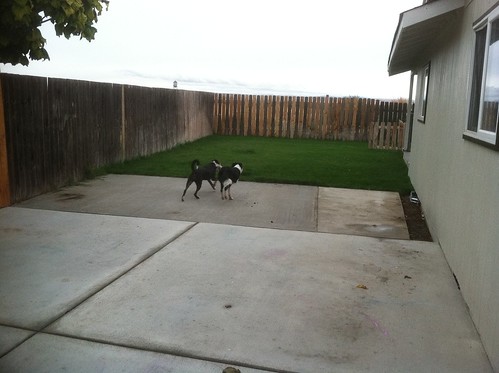
And a porch.
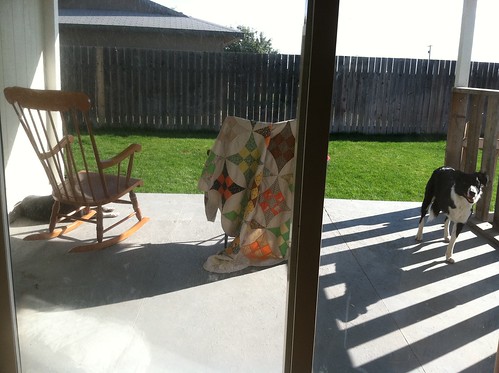
And a backyard.
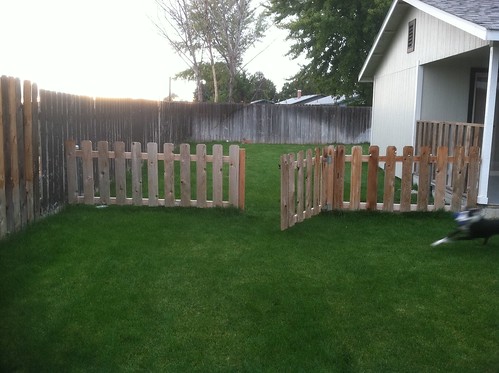
A very large backyard. I could fit an entire freakin' agility course back here.

Zelda says this is better than being a condo collie.

It occurred to me just now that the master bedroom is larger than the studio apartment Tom and I shared when we first got engaged.
I guess this means I'm stuck in this damn desert for a while longer. I long for the temperate rainforest of my youth. Though I am enjoying the significantly lower cost of living out here in the land of dust and Russian thistle.
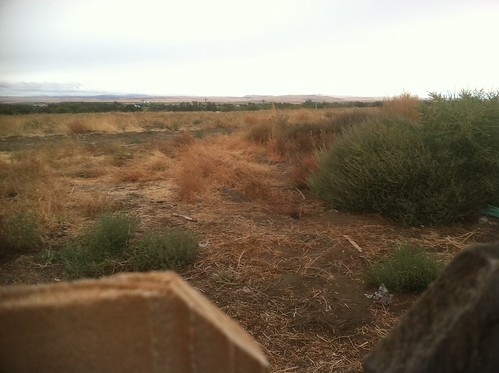
(This is the reason I've been MIA for a month, in case you were curious)
It has a patio.

And a porch.

And a backyard.

A very large backyard. I could fit an entire freakin' agility course back here.

Zelda says this is better than being a condo collie.

It occurred to me just now that the master bedroom is larger than the studio apartment Tom and I shared when we first got engaged.
I guess this means I'm stuck in this damn desert for a while longer. I long for the temperate rainforest of my youth. Though I am enjoying the significantly lower cost of living out here in the land of dust and Russian thistle.

Saturday, September 24, 2011
The Latest Project
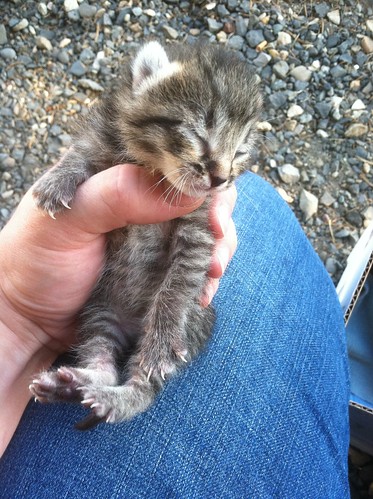
Found on a nature trail and brought into the clinic by a good Samaritan.
I think he's a male, but not positive; tiny kittens are difficult to sex. His eyes should open any day now.
Judging by the area he was found, his mother is probably a feral. She may have been startled and dropped him, or was planning to return to get him later. So we'll never know if he was truely 'abandoned'. But you never know. We had another 'orphaned' kitten brought in a few months ago where the mother (a feral, though apparently healthy) left one of her kittens in a bush near an apartment and didn't come back for over 24 hours. A person couldn't stand looking at it anymore and took it in and started bottle feeding. Three days later the mother returned to the bush and sniffed around like, "huh, didn't I leave something here?"
Maternal instinct is a variable thing. At worse, he was saved from being a feral cat. I told him, on his first night here, as he spat out the rubber bottle nipple over and over and cried for the real thing, that life is tough sometimes and he would just have to get used to it and things would work out. Maybe he understands this, because now, two days later, he thinks formula and rubber nipple are just fine and dandy.
He'll be ready to go to a new home in five to six weeks.
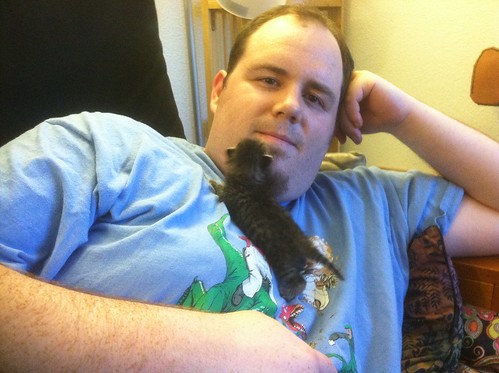
Me: "Will you hold him while I make up his bottle?"
Tom: "Will he poop on me?"
Me: "He can't poop on his own yet. So unless you plan to lick his genitals to stimulate that, you should be fine."
Tom: "Wasn't planning on it."
This dog intrigues me
I went out with a doctor to a rancher's house to check a horse with an injured foot. He'd called us ahead of time to let us know no one would be home but that the mare was easy to catch. We drove up and parked near the house and two dogs trotted out to greet us.
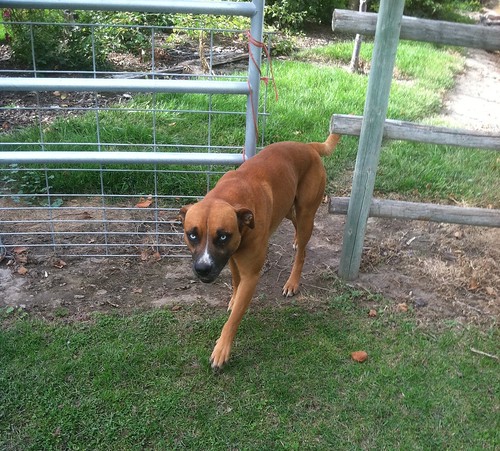
Terrible guard dogs, both of them. They each let out a few cursory barks, then came over to sniff us, tails wagging in a friendly manner. Then they both flopped down to supervise as we took a look at the mare.
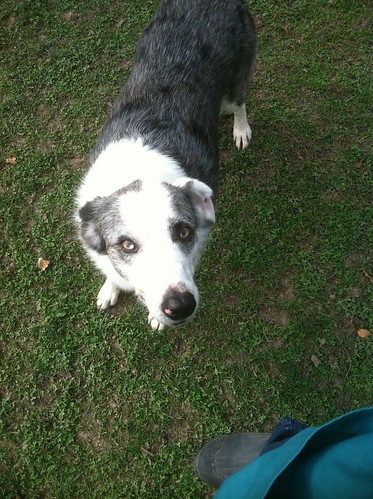
They have the confident, laid-back demeanor of true farm dogs. They have a hundred acres to run on, yet even though they're both unaltered they stay near the house. They rarely see a kennel or a leash. They're both fit and trim. They've been well-socialized to people and other dogs and animals by the constant stream of workers that come through to work with the cows.
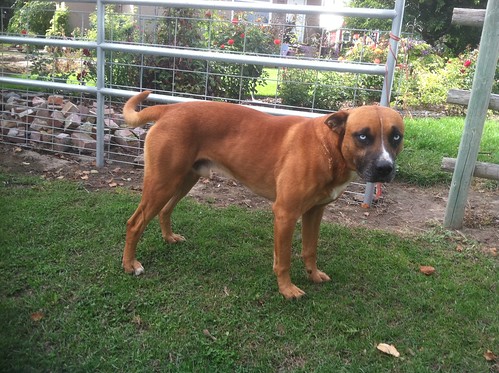
I don't know what mix of breeds created this guy, but those eyes catch your attention, don't they? I don't know where the rancher got him, or what he uses him for or if he's just a pet.
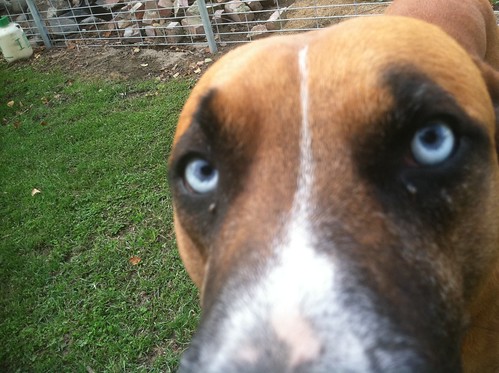
He looks like he could be a street dog from just about anywhere in the world.
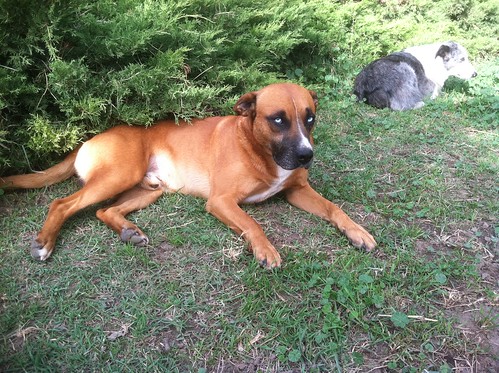

Terrible guard dogs, both of them. They each let out a few cursory barks, then came over to sniff us, tails wagging in a friendly manner. Then they both flopped down to supervise as we took a look at the mare.

They have the confident, laid-back demeanor of true farm dogs. They have a hundred acres to run on, yet even though they're both unaltered they stay near the house. They rarely see a kennel or a leash. They're both fit and trim. They've been well-socialized to people and other dogs and animals by the constant stream of workers that come through to work with the cows.

I don't know what mix of breeds created this guy, but those eyes catch your attention, don't they? I don't know where the rancher got him, or what he uses him for or if he's just a pet.

He looks like he could be a street dog from just about anywhere in the world.

Sunday, September 11, 2011
An Epic Battle
Mantids are scary. If they were the size of cats, I think we'd be screwed.
I was already a little freaked out by them, with their too-intelligent eyes that follow you when you walk by. Then I had to go and witness this:
I was cleaning the large animal area at work the other day when I noticed three praying mantis sitting together on a fence post. Two larger ones which I assumed were females, and a smaller one, probably male. I admired them for a moment, then continued on with my work. A few minutes later, I glanced over at them just in time to see one of the females take a few steps and leap onto the other female, grasping her thorax. Soon it was a fight to the death. They grappled, biting at each other's faces and arms.
A few minutes after that, I watched the male tiptoe closer and closer to the fight, then finally hop onto the back of the attacking female and start to mate with her as she was killing (and eventually decapitating and eating) the other female. I don't know his fate, because I had to go back inside. But when I came out an hour later, only the (now engorged) victorious female remained on the fence, with a pathetic pile of shredded wings on the ground below her feet.

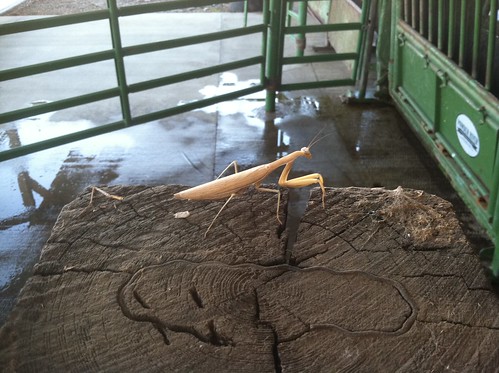
Nature, red in tooth and claw, indeed.
I was already a little freaked out by them, with their too-intelligent eyes that follow you when you walk by. Then I had to go and witness this:
I was cleaning the large animal area at work the other day when I noticed three praying mantis sitting together on a fence post. Two larger ones which I assumed were females, and a smaller one, probably male. I admired them for a moment, then continued on with my work. A few minutes later, I glanced over at them just in time to see one of the females take a few steps and leap onto the other female, grasping her thorax. Soon it was a fight to the death. They grappled, biting at each other's faces and arms.
A few minutes after that, I watched the male tiptoe closer and closer to the fight, then finally hop onto the back of the attacking female and start to mate with her as she was killing (and eventually decapitating and eating) the other female. I don't know his fate, because I had to go back inside. But when I came out an hour later, only the (now engorged) victorious female remained on the fence, with a pathetic pile of shredded wings on the ground below her feet.


Nature, red in tooth and claw, indeed.
Monday, August 29, 2011
Guess the mixed breed - Answer
Saturday, August 27, 2011
Peekaboo
Friday, August 26, 2011
Nom nom
On a recent walk in the field near the apartments, I spotted a flash of iridescent green amid the dead cheatgrass.
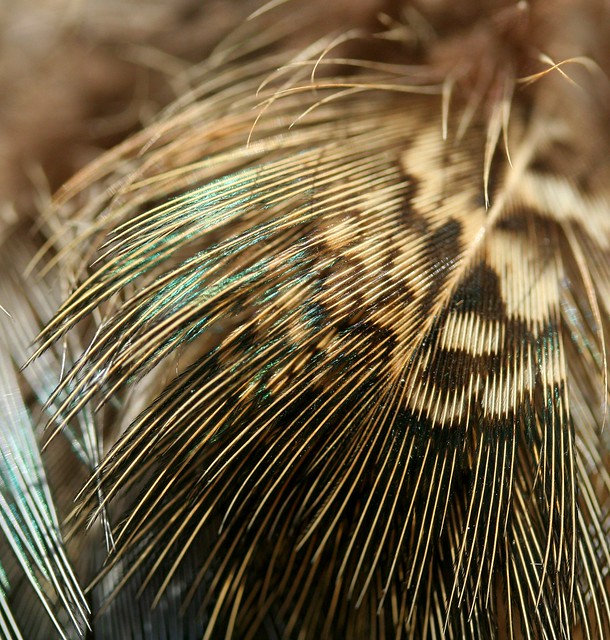
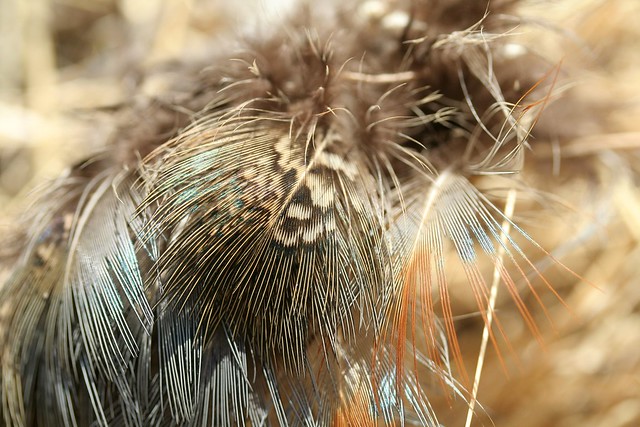
It was a chunk of what used to be a bird, feathers with a bit of skin and bone attached. I bent down and took a few photographs, planning on picking it up to try to identify the species. Within seconds, Sammie swooped in centimeters from my lens and snatched the delicious morsel and ran a few yards away. She crunched it down like it was the best thing she'd ever tasted, all the while giving me the paranoid "OMG-mom's-gonna-take-it-away-any-second" glances that dogs are so good at.

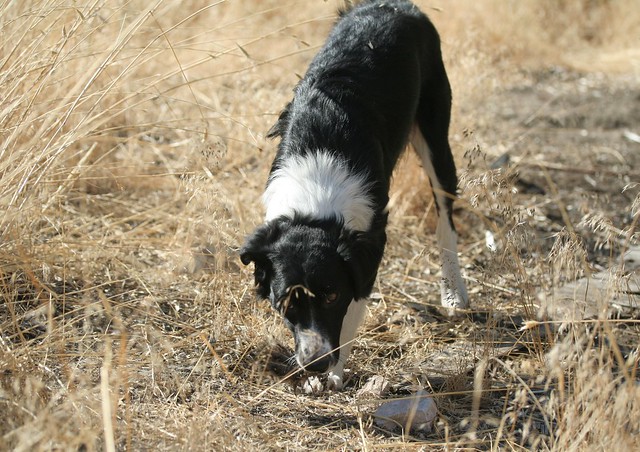
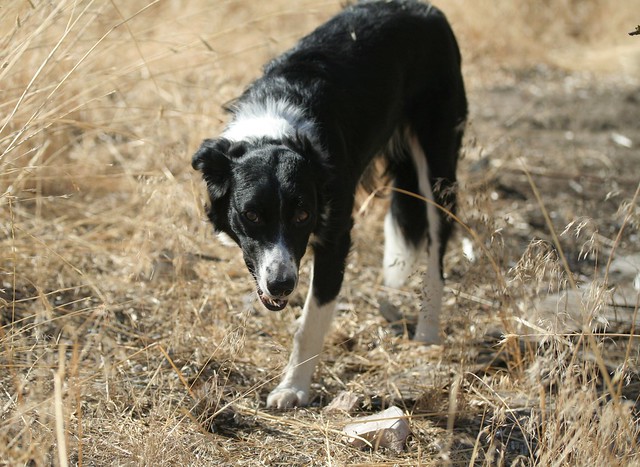
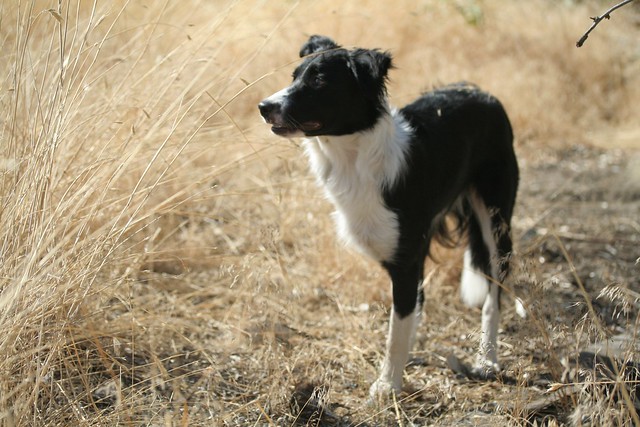
So. Can anyone use these two photographs to identify the species of bird my dog just ate?


It was a chunk of what used to be a bird, feathers with a bit of skin and bone attached. I bent down and took a few photographs, planning on picking it up to try to identify the species. Within seconds, Sammie swooped in centimeters from my lens and snatched the delicious morsel and ran a few yards away. She crunched it down like it was the best thing she'd ever tasted, all the while giving me the paranoid "OMG-mom's-gonna-take-it-away-any-second" glances that dogs are so good at.




So. Can anyone use these two photographs to identify the species of bird my dog just ate?
Thursday, August 25, 2011
Season of the Mantis
Guess the mixed breed
Two can play at this game.

According to her owners, who also own the mother, this girl is the result of the "oops" mating of two very different, AKC-registered parents.
What do you think the breeds are?

According to her owners, who also own the mother, this girl is the result of the "oops" mating of two very different, AKC-registered parents.
What do you think the breeds are?
Sunday, August 21, 2011
The trouble with being a three-legged dog
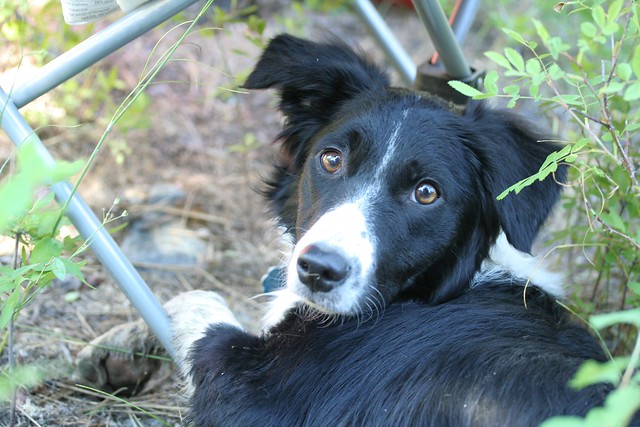
When you've worn through your only front pad due to an over-abundance of hiking, river-splashing, and general romping in the forest, you can't really limp. All you can manage is an incredibly pathetic hop-stumble that makes everyone in camp feel sorry for you.

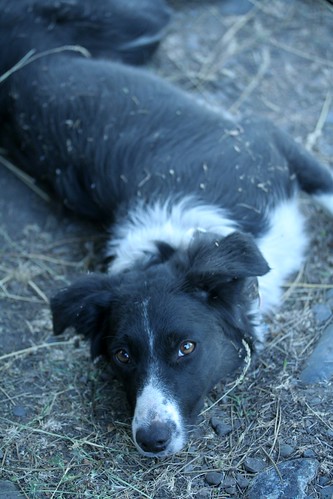
Luckily, some three-legged dogs have help when this occurs.

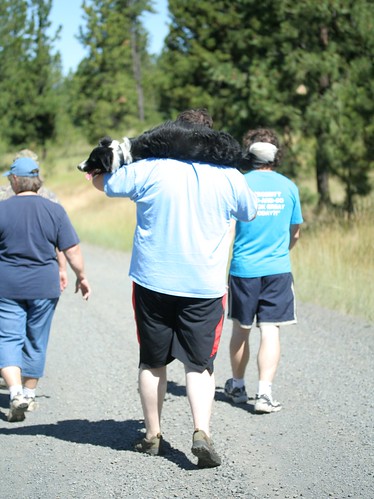
Thursday, August 18, 2011
Highway 14: the lesser-used side of the Columbia Gorge
On a recent sojourn to Portland we decided to skip the interstate and take the narrower, windier, generally higher-in-elevation road on the Washington side of the River.
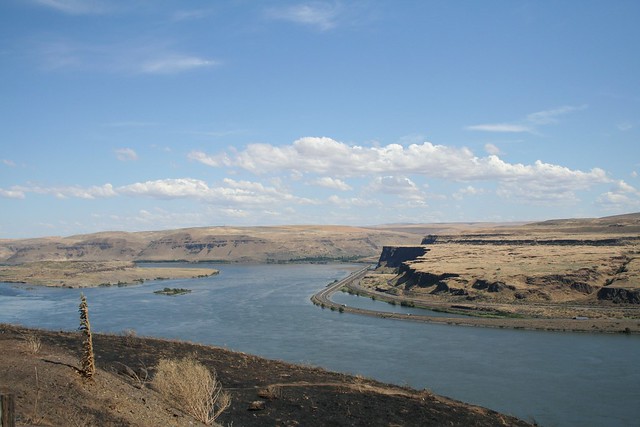
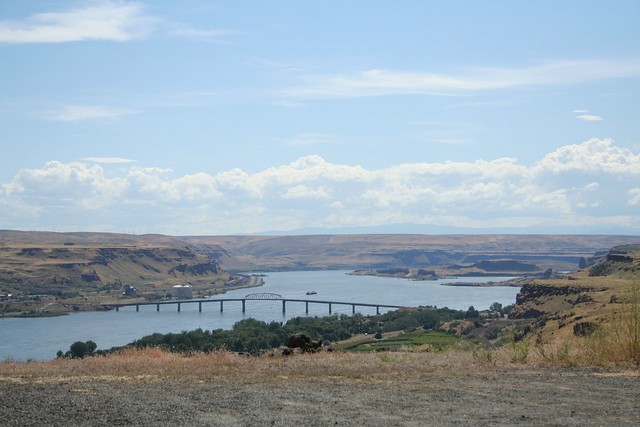
If you're traveling through the area (and if you are, you really only have two choices), consider taking this route. There are many places to easily pull off to enjoy the sweeping vistas, several cute little towns with cute little fruit stands and cafes and you get better close up views of the windmills.
Oh, did I mention there's a life-sized replica of Stonehenge?



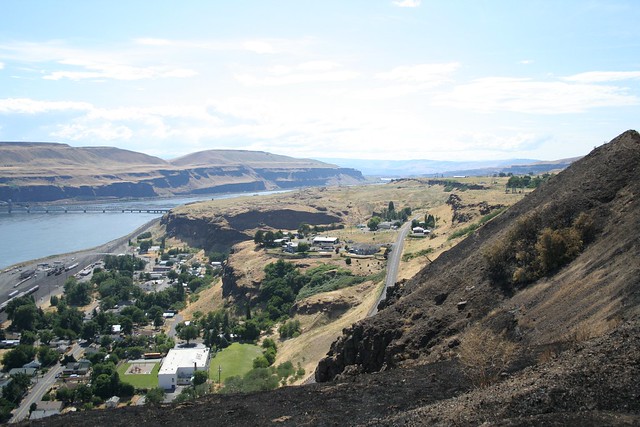




If you're traveling through the area (and if you are, you really only have two choices), consider taking this route. There are many places to easily pull off to enjoy the sweeping vistas, several cute little towns with cute little fruit stands and cafes and you get better close up views of the windmills.
Oh, did I mention there's a life-sized replica of Stonehenge?






Sunday, August 14, 2011
What the heck?
Thursday, August 11, 2011
Sunday, August 7, 2011
Why You Wouldn't Adopt To Me
July was a stupid-busy month for me, which is why I haven't been around the blog-o-world much lately. I'm a bit late to the party in the talking about the No-Kill Conference that so many awesome people are talking about.
I get jazzed talking/reading about animal rescue. I have a lot to say on the subject, but tonight my eye was caught by one subject in particular. Adopting (or not) to "imperfect" homes.
Yesbiscuit has the best commentary on it, I think. You should go read her blog post. And the comments. Although, I had to stop when I got to this comment:
"But I will be damned if I will knowingly see any of our dogs go to live on a chain. No way ... And perhaps the “adopter” will just go get another dog someplace else. But the “education” that keeps being mentioned here starts with letting the public know that we don’t feel that every situation is OK."
This attitude, this zero-tolerance policy for this thing, or that thing that some (many!) pet owners practice, is a large reason why "backyard breeders"/Walmart puppies/Craigslist rescues are so popular. There are quite a few blogs/forums I've quit reading because of this attitude.
Why You Wouldn't Adopt To Me:
1) I live in an apartment.
2) My husband and I both work full time.
3) I feed my dogs Science Diet Adult dry kibble.
Somehow I manage two border collies (at least one of which of pure working cowdog breeding), two cats, usually a foster dog of some kind, and sometimes some rats. By any measure that any reasonable person could use, my pets are healthy and happy. Furthermore, the cowdog for sure, and probably the other dog and both cats, and some of the rats, would be dead if I hadn't taken them in.
My home isn't good enough to adopt YOUR animals, though.
Why You Wouldn't Adopt To My Parents:
1) They both work full time.
2) They chain their dog in the yard while they're gone.
3) They allow their cat outdoors.
When I was growing up, pets used to only be allowed indoors if they were recovering from injury, or during lightning storms. As we grew, and got more educated as pet owners (from the vet, from friends, from the media) our dogs and cats were then allowed into the kitchen, and now have the run of the house. When I was a kid, the dog was lucky to go to the vet every few years to get shots, and the cat probably not at all; now my parents take their current pets in for all kinds of things that would have been unthinkable 20 years ago (for them): teeth cleanings, cruciate ligament surgery, arthritis evaluations, treatment for skin conditions.
But my parents keep their dog chained in the yard during the day while they're at work. So their home isn't good enough. The end. Many rescuers would tear up their adoption application right then. It's ridiculous. My parents live in the country, on a long private drive away from busy roads or harassing children. All the arguments against chaining don't apply to him. Context? Matters.
Why You Wouldn't Adopt To Most Of My Friends, Co-workers, Bosses, Clients, and Acquaintances:
1) They keep their dogs chained/penned during the day; or they work full time; or they don't allow dogs indoors at all; or they feed cheap food; or they previously gave up a dog for adoption for one reason or another; or they don't have a fenced yard; or they're over 60 years old; or they have small children; or ...
When even Nathan Winograd is rejected from adopting a dog because he didn't have a frickin' doggy door, you know it's bad.
Perspective. Get some.
It cannot be stated enough: the alternative for these pets is DEATH.
If my parents can make chaining their dog during the day work, then others can, too.
If I can make having two high-energy, high-drive dogs in an apartment work, others can, too.
If my friend's dog lives a happy, loved life even though she's never allowed indoors, others can, too.
If another friend can have two small children and two large dogs in the same house, others can, too.
There are a few black and white issues in animal rescue. These are not. And I get more and more peeved when those in the rescue community treat them as such.
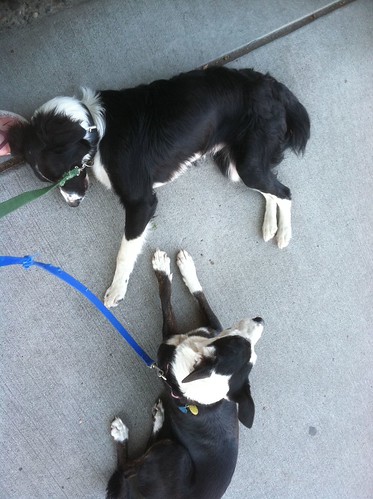
Condo Collies out in the wild
I get jazzed talking/reading about animal rescue. I have a lot to say on the subject, but tonight my eye was caught by one subject in particular. Adopting (or not) to "imperfect" homes.
Yesbiscuit has the best commentary on it, I think. You should go read her blog post. And the comments. Although, I had to stop when I got to this comment:
"But I will be damned if I will knowingly see any of our dogs go to live on a chain. No way ... And perhaps the “adopter” will just go get another dog someplace else. But the “education” that keeps being mentioned here starts with letting the public know that we don’t feel that every situation is OK."
This attitude, this zero-tolerance policy for this thing, or that thing that some (many!) pet owners practice, is a large reason why "backyard breeders"/Walmart puppies/Craigslist rescues are so popular. There are quite a few blogs/forums I've quit reading because of this attitude.
Why You Wouldn't Adopt To Me:
1) I live in an apartment.
2) My husband and I both work full time.
3) I feed my dogs Science Diet Adult dry kibble.
Somehow I manage two border collies (at least one of which of pure working cowdog breeding), two cats, usually a foster dog of some kind, and sometimes some rats. By any measure that any reasonable person could use, my pets are healthy and happy. Furthermore, the cowdog for sure, and probably the other dog and both cats, and some of the rats, would be dead if I hadn't taken them in.
My home isn't good enough to adopt YOUR animals, though.
Why You Wouldn't Adopt To My Parents:
1) They both work full time.
2) They chain their dog in the yard while they're gone.
3) They allow their cat outdoors.
When I was growing up, pets used to only be allowed indoors if they were recovering from injury, or during lightning storms. As we grew, and got more educated as pet owners (from the vet, from friends, from the media) our dogs and cats were then allowed into the kitchen, and now have the run of the house. When I was a kid, the dog was lucky to go to the vet every few years to get shots, and the cat probably not at all; now my parents take their current pets in for all kinds of things that would have been unthinkable 20 years ago (for them): teeth cleanings, cruciate ligament surgery, arthritis evaluations, treatment for skin conditions.
But my parents keep their dog chained in the yard during the day while they're at work. So their home isn't good enough. The end. Many rescuers would tear up their adoption application right then. It's ridiculous. My parents live in the country, on a long private drive away from busy roads or harassing children. All the arguments against chaining don't apply to him. Context? Matters.
Why You Wouldn't Adopt To Most Of My Friends, Co-workers, Bosses, Clients, and Acquaintances:
1) They keep their dogs chained/penned during the day; or they work full time; or they don't allow dogs indoors at all; or they feed cheap food; or they previously gave up a dog for adoption for one reason or another; or they don't have a fenced yard; or they're over 60 years old; or they have small children; or ...
When even Nathan Winograd is rejected from adopting a dog because he didn't have a frickin' doggy door, you know it's bad.
Perspective. Get some.
It cannot be stated enough: the alternative for these pets is DEATH.
If my parents can make chaining their dog during the day work, then others can, too.
If I can make having two high-energy, high-drive dogs in an apartment work, others can, too.
If my friend's dog lives a happy, loved life even though she's never allowed indoors, others can, too.
If another friend can have two small children and two large dogs in the same house, others can, too.
There are a few black and white issues in animal rescue. These are not. And I get more and more peeved when those in the rescue community treat them as such.

Condo Collies out in the wild
Monday, August 1, 2011
Flipper got adopted!
A bit earlier than expected, but he went to a friend who doesn't mind weaning him and potty-training. They live just down the road and used to work at the clinic, so I'll get visits and photos and cuddles without having to do any more work. Which is exactly the way I like my puppy interactions. Everyone wins! Yay, fostering!

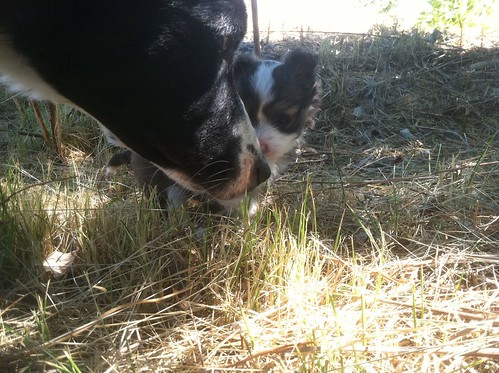


Thursday, July 21, 2011
A little close for comfort
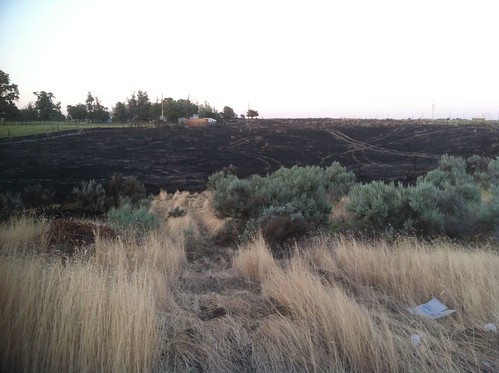
We had a wee prairie fire sweep by our apartment last week. Missed us by at least 50 yards. The temperture outside was around 100 degrees F, the winds were around 40 miles and hour, and the humidity was somewhere between 'very low' and 'surface of the moon'. I say 'wee' because it only burned one house and several dozen acres, many of those acres being the field where I take the dogs on their walk every day. It could have been very much worse.
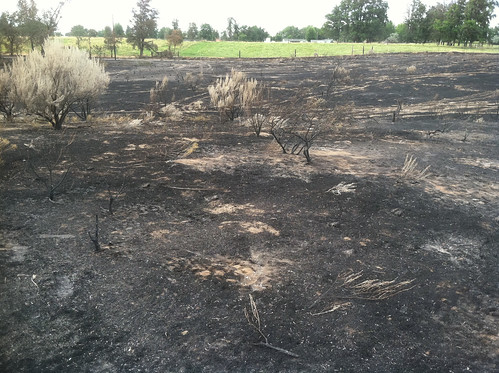
Tip for homeowners: if you're going to mow your dry lawn on a summer afternoon in the desert, clean debris from around your mower's muffler periodically.
I took a walk through the area a few days later. The fire did exactly what a wildfire is supposed to do: burn hot and fast, turning the dried annual plants into fertilizer dust and allowing woody shrubs and hardier plants and roots to survive.
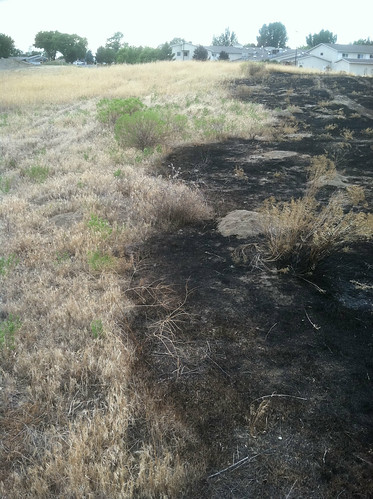
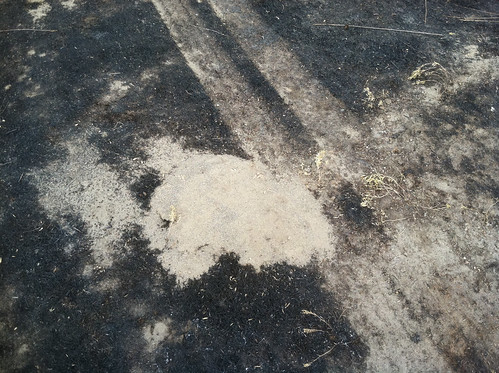
Note the ant hill activity in the middle of the burn area. It was too soon for them to have migrated from an unaffected area. I'm assuming they survived under the soil while the fire burned over their little heads.
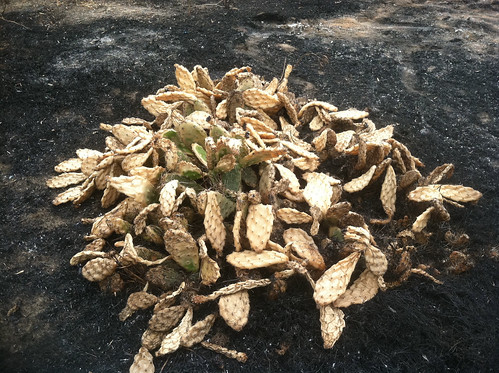
The middle of this cactus (prickly pear?) will probably live to put spines into the feet of dogs for years to come.

I found several roasted grasshoppers, but couldn't bring myself to eat any of them.
Subscribe to:
Posts (Atom)

